Global Land Outlook Report on Rangelands and Pastoralists
Global Land Outlook Thematic Report on Rangelands and Pastoralists released
- This report by the UN Convention to Combat Desertification (UNCCD) focuses on the relationship between rangelands and their human communities, especially pastoralists, to identify approaches for rangeland protection.
- Rangelands are natural or semi-natural ecosystems grazed by livestock and/or wild animals.
- They often comprise a mosaic of ecosystems such as grasslands, savannahs, shrublands, drylands, deserts, steppes, mountains, open forests, and agroforestry systems.
Key highlights of the report
- Rangelands cover over 54% of terrestrial surface, with around 78% occurring in drylands.
- Up to 50% of rangelands are estimated to be degraded showing signs of diminished soil fertility and nutrients, erosion, salinization, alkalinization, and soil compaction inhibiting plant growth.
- Drivers of degradation include land use changes due to population growth and urban expansion, rapidly rising food, fiber, and fuel demands, excessive grazing, abandonment, and policies that incentivize overexploitation.

Rangeland status in India:
- Indian rangelands occupy about 121 million hectares, and around 100 million hectares is considered underutilized.
- Pastoralists have been widely marginalized in Indian public policies, resulting in insecure tenure rights and access to their pool of common resources.
- In many states, pastoralists have been banned from forests and protected areas.
- Mining and energy projects also prevent their access to critical rangeland resources.
Key Recommendations
- Integrated climate change mitigation and adaptation strategies boosting the resilience of pastoralist communities.
- Reduce rangeland conversion and other land use changes that diminish the diversity and multifunctionality of rangelands
- Adopt and support pastoralism-based strategies and practices that help mitigate harm to rangeland health.
- Tags :
- UNCCD
- Rangelands
- Global Land Outlook Thematic Report
World Wildlife Crime Report 2024
United Nations Office on Drugs and Crime (UNODC) released World Wildlife Crime Report 2024.
Key findings
- During 2015-2021, rhinoceroses and cedars were the most impacted animal and plant species respectively.
- The largest number of seizures reported during 2015- 2021 involved corals, followed by crocodilians and elephants.
- For seizures of animal species, there is a gradual increase from 2015–2019 and then decline in 2020 and 2021.
- For seizures of plant species, there is sharp increase in 2020 and 2021.
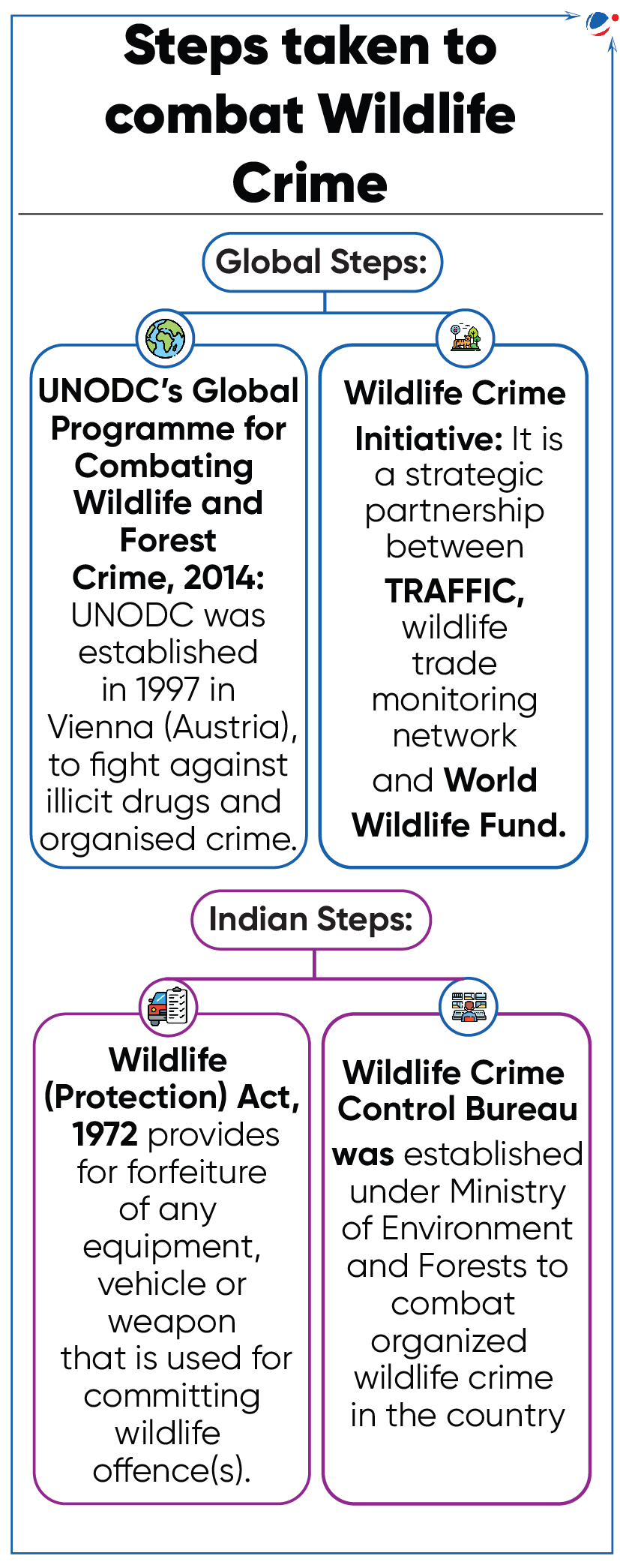
Wildlife crime
- It can be defined as taking, possession, trade or movement, consumption of wild animals and plants or their derivatives in contravention of any international, regional, or national legislation(s).
Factors driving wildlife crime
- Demand for medicine, pets, bushmeat, ornamental plants etc.
- Huge profits earned by illegal traders by selling exotic animals, plants, and their parts. Eg. Rhinoceros horn, etc.
- Corruption undermines government restrictions on wildlife harvest, trade, and use, thus enabling wildlife crime.
Impact of Wildlife Crime
- Environmental: Overexploitation and reduced populations of wildlife species; Increasing invasive alien species etc.
- Out of all seized fauna, 40% were either threatened or near-threatened on the red list.
- Economical: Money laundering and illegal cross-border financial flows.
- Social: Risks of disease transmission to people from live animals, plants, wildlife meat; Degradation of services like food, medicines, energy, etc.
- Governance Harms: Undermining the role of governments; Loss of government revenues; Enforcement costs etc.
- Tags :
- World Wildlife Crime Report 2024
- Wildlife crime
- UNODC
Sea Anemone
Scientists have found mass sea anemone bleaching off Agatti island, Lakshadweep.
About Sea anemone:
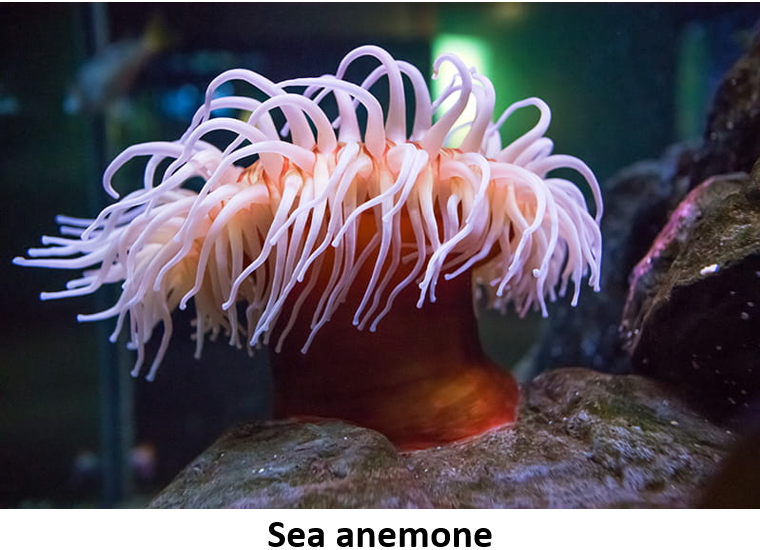
- They are ocean-dwelling members of the phylum Cnidaria.
- Sea anemones are predatory animals and most species are found in coastal tropical waters.
- Like corals, sea anemones establish symbiotic relationships with green algae.
- Sea surface temperature rise disrupts this relationship, resulting in bleaching.
- They also have a symbiotic relation with clownfish.
- Clownfish are protected by the stinging tentacles of anemone and anemone gets food from Clownfish’s meals.
- They play key biogeochemical roles in benthic ecosystems.
- Tags :
- Sea Anemone
- Phylum Cnidaria
Baseflow
A recent study highlighted that Baseflows have a stronger triggering effect on river floods in Peninsular India as compared to rainfall and soil moisture.
- The six rivers studied include Narmada, Tapi, Mahanadi, Godavari, Krishna and Cauvery.
Baseflow:
- Baseflows are streamflows which results from precipitation that infiltrates into the soil and eventually moves through soil to the stream channel.
- This is often called groundwater flow or dry-weather flow.
- Tags :
- Baseflow
- Peninsular India
Batagay Crater
Newly captured aerial footage of Batagay Crater has revealed that it is growing every year as the frozen ground melts.
About Batagay (also spelled Batagaika) crater
- It is also known as the “Gateway to Underworld” or “Doorway to Hell” and is the world's biggest permafrost crater.
- Located in Siberia, Russia, it is a massive, expanding depression on Earth's surface, formed due to permafrost thaw.
- Since the 1960s, its growth accelerated due to deforestation and climate change.
- From 1991 to 2018, the crater area increased by almost three times.
- Tags :
- Batagay Crater
- Doorway to Hell
- Gateway to Underworld
Venezuela May be the First Nation to Lose All its Glaciers
According to the International Cryosphere Climate Initiative (ICCI), the Humboldt (or La Corona) - Venezuela’s last standing glacier in the Andes, has shrunk to a size that no longer qualifies it as a glacier.
- ICCI is a network of experts and researchers collaborating with governments and organizations to preserve the Earth’s cryosphere.
- Cryosphere includes snow and ice on land, ice caps, glaciers, permafrost, and sea ice.
- A glacier is an accumulation of ice and snow that slowly flows over land.
- Glaciers are melting at a fast rate mainly due to global warming, warming of ocean water etc.
- Both Alpine (e.g. Hindu Kush Himalaya) and Ice sheets (e.g. Antarctica) have been impacted.
Impacts of Glacier Melting
- Sea Level Rise: As per NASA, if all glaciers and ice sheets melted, global sea level would rise by more than 60 meters.
- It will increase coastal erosion and elevate storm surge.
- Biodiversity Loss: Walrus are losing their home and polar bears are spending more time on land, causing higher rates of conflict between people and bears.
- Disasters: Frequency of Glacial Lake outbursts (GLOFs) in regions like Himalayas will increase.
- Other: Reduction in water availability in rivers like Ganges, economic activities like fishing and navigation will be impacted etc.
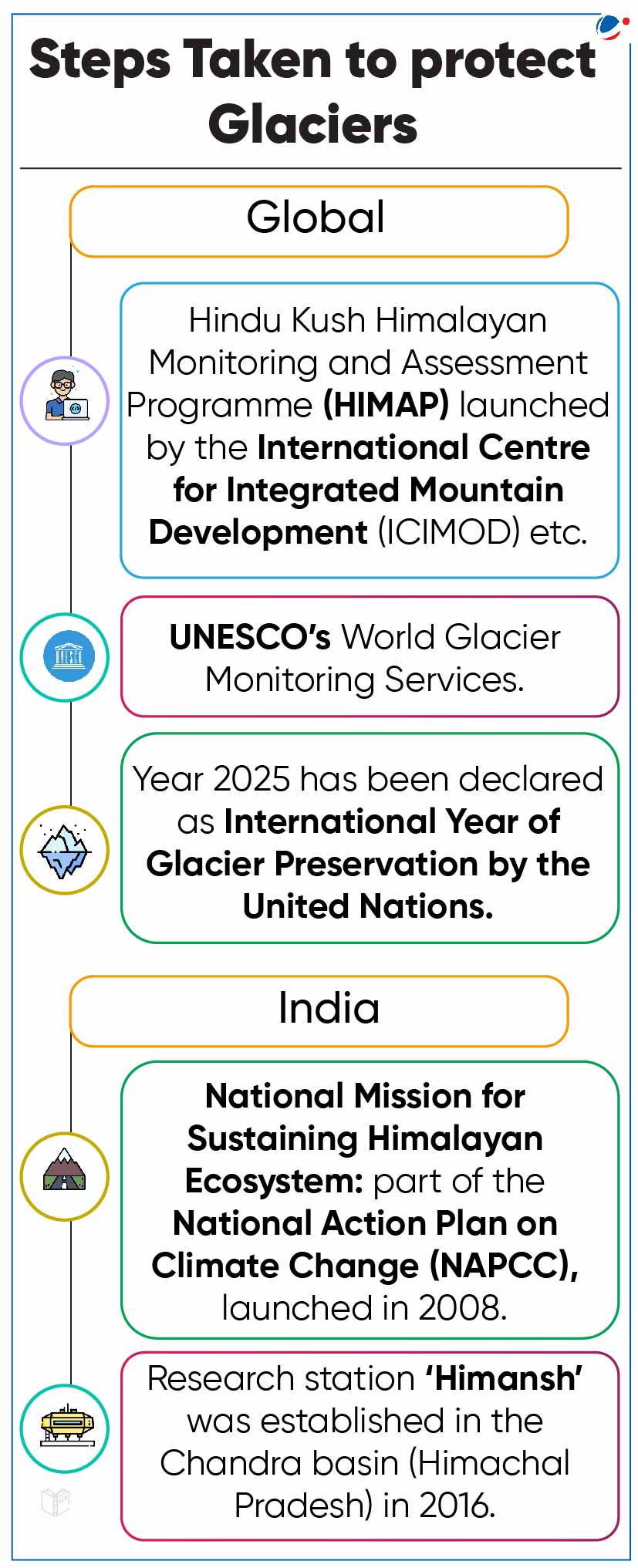
- Tags :
- International Cryosphere Climate Initiative
- Glacial Lake outbursts (GLOFs)
Climate Change can Weaken Monetary Policy Transmission: RBI
Monetary policy is an adjustment of the supply of money in the economy by the Reserve Bank of India(RBI) to achieve a combination of inflation and output stabilization.
Climate change effects on monetary policy
- Directly impacts inflation through adverse weather events affecting agricultural production and global supply chains.
- Impact the Natural Rate of Interest (NRI) due to increasing temperatures and occurrence of Extreme weather events undermining productivity and lowering potential output.
- NRI is a real short-term interest rate consistent with output at its potential and a stable rate of inflation.
- It is one element which helps to define the monetary policy stance (accommodative, neutral or restrictive).
- Impact the financial health of banks and other financial institutions, the value of assets, and the economic expectations of individuals and businesses.

Way forward
- Adopting green taxonomy, which is a framework to assess the sustainability credentials and possible ranking of economic activity.
- Need to incorporate climate risk into their modeling frameworks used for monetary framework.
- Tags :
- Climate change on monetary policy
- Natural Rate of Interest (NRI)
New Collective Quantified Goal on Climate Finance (NCQG)
Parties to the UNFCCC have made new submissions for the NCQG under Paris Agreement.
- New Collective Quantified Goal on Climate Finance (NCQG) was proposed in COP21 for setting post-2025 climate finance goal (new goal).
- In 2009 parties to UNFCCC had decided to mobilise $100 billion annually by 2020 which was subsequently extended to 2025.
- However, this target is yet to be achieved reflecting significant shortfalls in it.
- NCQG is proposed to raise the floor on climate finance above the current $100 billion annual target while also addressing key shortcomings in the current climate financing mechanism by:
- setting both qualified and quantified targets in line with needs;
- agreeing suitable modalities for financing mitigation, adaptation and loss and damage; and
- building deeper levels of accountability and transparency into the goal.
Issues associated with the target of mobilising $100 billion annually
- Distributional imbalance: Between 2011 and 2020, 80% of global climate finance was focused in OECD countries and the East Asia Pacific region, revealing a significant geographical concentration of funds.
- Overemphasis on financing of mitigation: Adaptation made up only about 8% of the total climate financing in 2019-2020)
- Nature of Climate Finance: Nearly 94% of existing climate investment is either through either debt or equity (return seeking).
Paris Agreement (2015) on Climate Financing
|
- Tags :
- NCQG
- Paris Agreement (2015)
Carbon Removals and Carbon Farming (CRCF) regulation in European Union (EU)
European Parliament and the European Council recently reached a provisional agreement on a regulation to establish the first EU-level Carbon Removal Certification Framework.
- This certification framework will boost innovative carbon removal technologies and carbon farming.
- It establishes quality criteria standards and outlines monitoring and reporting processes to prevent greenwashing.
- Greenwashing is a term used where a company makes false or misleading statements that their products/services are more sustainable than they are in reality.
About Carbon Farming:
- It uses regenerative practices to improve agriculture, restore ecosystems, and combat climate change by storing carbon and reducing emissions.
- Common Methods: Agroforestry, conservation farming (minimising soil disturbance), integrated nutrient management, Renewable Energy Production Grasslands Conservation, etc.
- Potential Benefits:
- Carbon Sequestration: Studies have shown agricultural soils can absorb 3-8 billion tonnes of CO2-equivalent every year.
- This capacity can bridge the gap between feasible emissions reductions and the indispensable stabilisation of the climate.
- Promoting Farmers Income: Carbon credit systems can incentivise farmers by providing additional income through environmental services.
- Carbon Sequestration: Studies have shown agricultural soils can absorb 3-8 billion tonnes of CO2-equivalent every year.
- Challenges: Inadequate policy support, lack of resources to invest in sustainable land management practices by small land holding farmers etc.
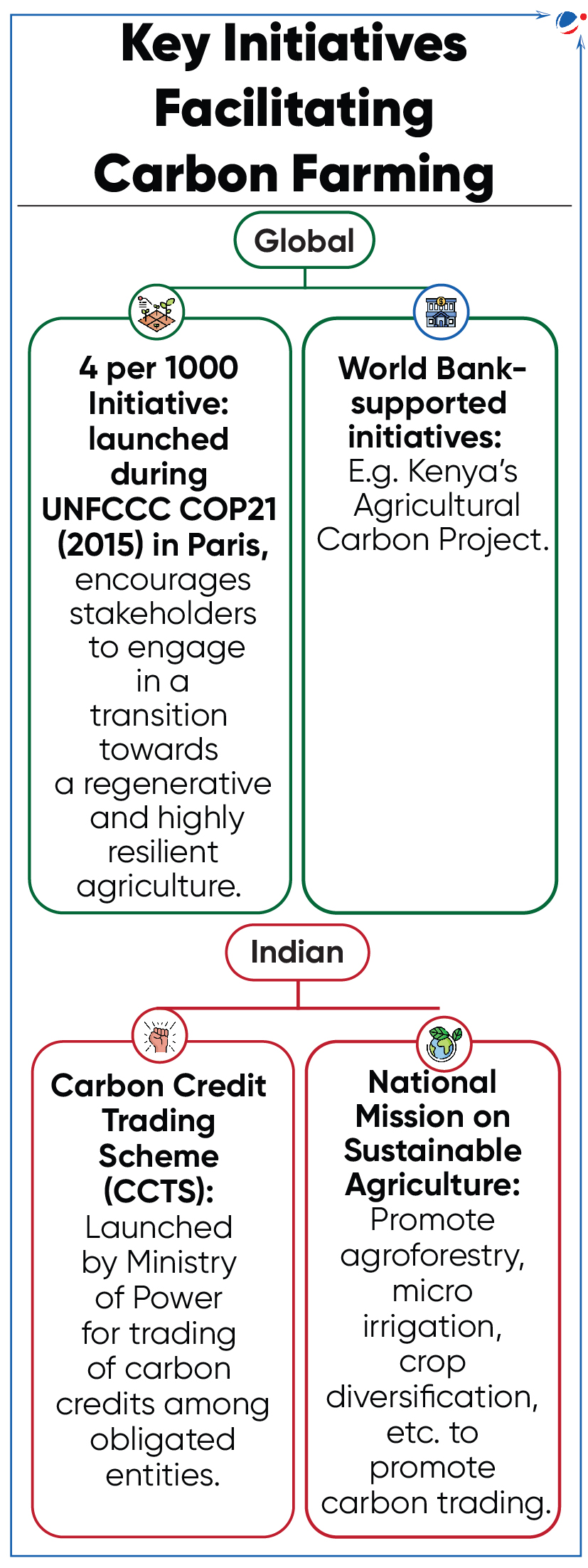
- Tags :
- Greenwashing
- Carbon Farming
- CRCF
Direct air capture and storage (DAC+S) plant
World’s largest DAC+S plant, Mammoth, started operation in Iceland.
- It is second commercial DAC+S facility of Swiss Company Climeworks and is much larger than its predecessor Orca.
DAC+S Technology:
- A Carbon Dioxide Removal (CDR) technology which capture CO2 directly from atmosphere at any location.
- It is distinct from carbon capture which is generally carried out at point of emissions.
- CO2 can be permanently stored in deep geological formations (DAC+S) or used for various applications.
About CDR:
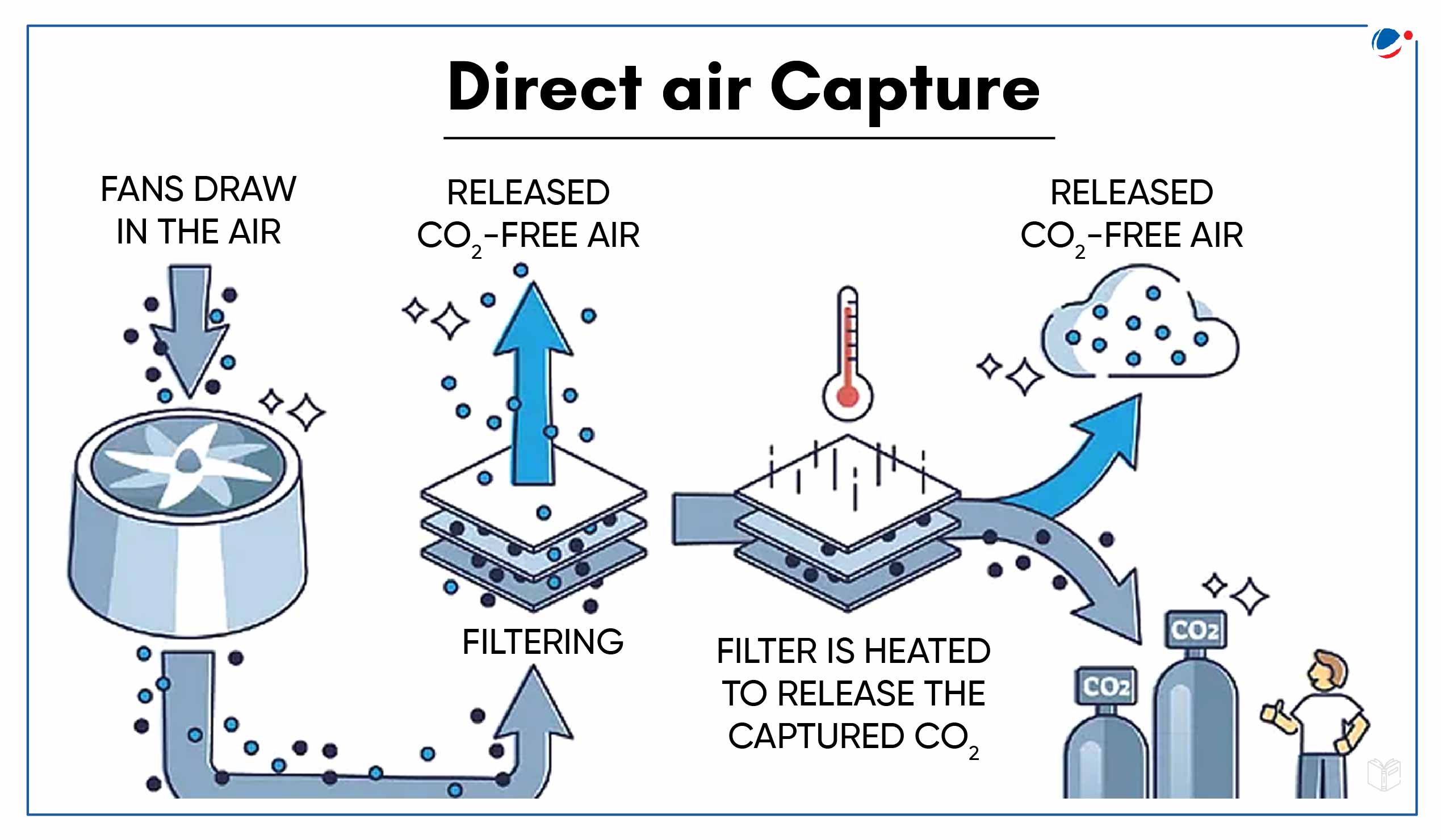
- CDR refers to anthropogenic activities that remove CO2 from atmosphere and store it durably in geological, terrestrial, or ocean reservoirs.
- According to IPCC Sixth Assessment Report, CDR is necessary element to achieve net-zero CO2 and GHG emissions.
Other CDR technologies:
- Afforestation/Reforestation and Soil Carbon Sequestration: Fixing atmospheric carbon in biomass and soils.
- Enhanced Weathering: Mining of rocks containing minerals that naturally absorb CO2.
- Ocean-based CDR: Ocean fertilisation (adding nutrients to upper layers), ocean alkalinity enhancement (transformation of CO2 as biocarbonate/carbonate), coastal blue carbon management etc.
- Bioenergy with Carbon Capture and Storage (BECCS): Using biomass as energy for CDR and storing biogenic carbon geologically.
Challenges in CDR
- Higher energy needs and costs, Air Pollution (through Mining), Significant land and water demand, ocean acidification etc
- Tags :
- DAC+S plant
- Carbon Dioxide Removal (CDR) technology
- Bioenergy with Carbon Capture and Storage (BECCS)
Keeling Curve
Global average concentration of carbon dioxide (CO2) was 4.7 parts per million (ppm) in March 2024 (higher than March 2023), signifying large spike in Keeling Curve.
- It is the largest ever recorded leap in CO2 concentration at 425.22 ppm.
About Keeling Curve
- It is the record of atmospheric CO2 from Mauna Loa Observatory (MLO), since 1958.
- MLO is a station that measures the elements in atmosphere that contribute to climate change.
- It is located in Hawaii on the side of Mauna Loa, the world’s largest active volcano.
- It is named after Dr. Charles David Keeling.
- Tags :
- Keeling Curve
- Mauna Loa Observatory (MLO)
Biocover
A recent study has proposed a sustainable approach of microbial methane oxidation system (called as biocover) to control fugitive methane emissions from old dumpsites.
- About Biocover
- Biocovers are porous material layer laid directly on top of a landfill which is then covered by an oxidizing layer of mature compost.
- It provides optimal conditions for methanotrophic (methane utilizing) bacteria to thrive and act as biofilters, hence control methane emissions by converting methane to CO2.
- Potential applications: Road construction, land reclamation, etc.
- Concerns: As they are found in old and deep dumpsites, they may be contaminated with heavy metals and microplastics.
- Tags :
- Biocover
- Methanotrophic
India Became Third Largest Solar Power Generator
This is highlighted as per Global Electricity Review (GER) 2024 report, released by global energy think tank Ember.
Key finding of the report
- Renewables provided 30% of global electricity for the first time.
- Solar was the main supplier of electricity growth in 2023.
- India saw the world's fourth-largest surge in solar generation in 2023 behind China, the US and Brazil.
- India overtook Japan to become the third-largest solar power generator in 2023, providing 5.9% of global growth in solar.
- India produced the second highest amount of electricity from coal.
- India’s per capita emissions from the power sector are the fourth lowest in the G20, despite high coal reliance.
- India’s per capita emissions from the power sector are just over half the global average and even further below the average in Asia.
Challenges in power sector:
- Drought conditions globally resulted in a record fall in hydropower generation.
- India’s electricity generation is more carbon-intensive than the global average.
- India also saw the second-highest increase in coal generation globally, behind China.
- Despite progress, wind, solar and other low-carbon sources are not yet growing fast enough to meet India’s rapidly growing electricity demand.
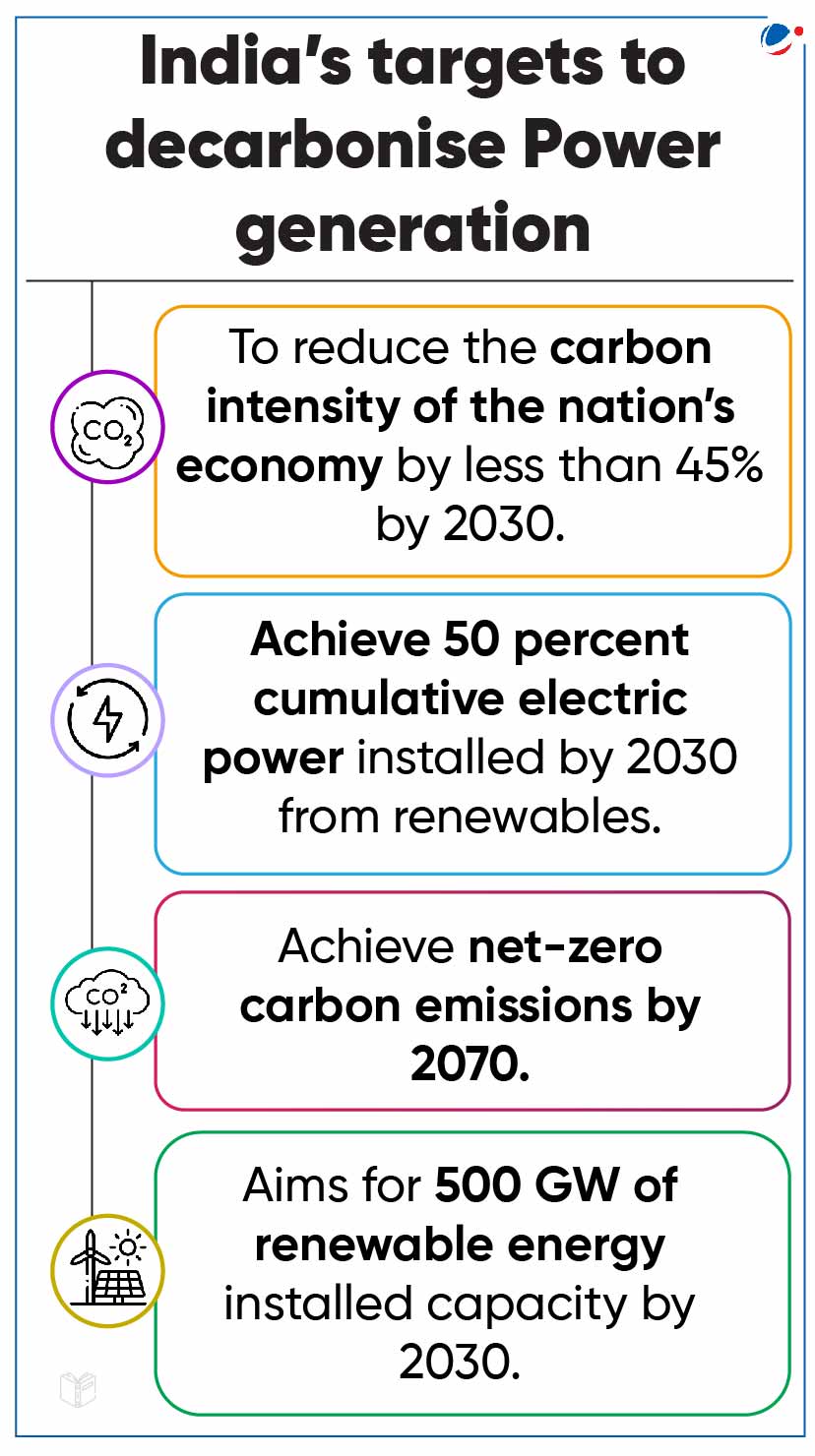
- Tags :
- Global Electricity Review (GER) 2024 report
- Third-largest solar power generator in 2023
Spain Becomes 99th Member Of International Solar Alliance (ISA)
About ISA
- Objective: A treaty-based intergovernmental organization that is an action-oriented, member-driven, collaborative platform for increased deployment of solar energy technologies.
- Genesis: Jointly launched by India and France in 2015 on the sidelines of COP-21 of the United Nations Framework Convention on Climate Change (UNFCCC) in Paris.
- It was officially established in 2017, with the entry into force of the ISA Framework Agreement.
- With the amendment of the Framework Agreement in 2020, all member states of the United Nations are eligible to join the ISA.
- Key Strategy: Guided by the ‘Towards 1000’ strategy. Under it, ISA aims to
- Mobilise USD 1,000 billion of investments in solar energy solutions by 2030
- Delivering energy access to 1,000 million people
- Installation of 1,000 GW of solar energy capacity.
- Observer Status of UN: In 2021, the UN General Assembly conferred Observer Status to the ISA.
- HQ: Gurugram, India
Significance of ISA
- Ensuring Just energy transition through solar by facilitating technology transfer, mobilising finance, etc.
- ISA along with initiatives like Global Biofuels Alliance and Coalition for Disaster Resilient Infrastructure are mechanisms for India to assert its soft power.
![An infographic titled "Initiatives taken by ISA" lists four initiatives: One Sun One World One Grid (OSOWOG), The Global Solar Facility (GSF), Solar Technology Application Resource Centre [STAR C] Initiative, and Development of Large-Scale Solar Power Projects.](https://d2av8kbir6lh9m.cloudfront.net/uploads/YO3AZg9vyqIOjmCqTpVocI6MfGD4XUYEkuBkFEKU.jpg)
- Tags :
- ISA
- International Solar Alliance
- United Nations Framework Convention on Climate Change (UNFCCC)



